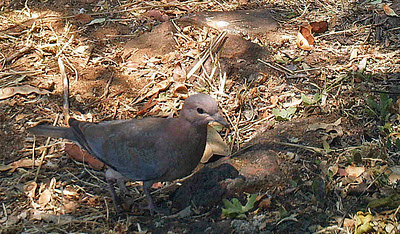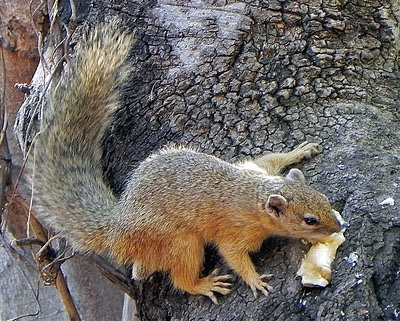This post wraps things up from the Magaliesberg trip. A couple of common bird species visited the cameras during the short period we were there.
 |
| Laughing Dove (Rooiborsduifie - Streptopelia senegalensis) in flight |
One can find the doves living throughout the whole of South Africa.
 |
| On the hunt... |
Another common species that you are bound to run into throughout most of South Africa is the Cape Robin-Chat.
 |
| The Cape Robin-Chat (Gewone Janfrederik - Cossypha caffra) is always friendly and inquisitive towards humans |
 |
| A proud little fellow |
The resident Natal Francolin also made the best of the feast. For the untrained eye these guys might look like the Cape Francolin (I commonly
photograph at Tygerberg), but there are subtle differences and their ranges don't overlap.
 |
| Natal Francolin (Natalse Fisant - Pternistes natalensis) sizing up a piece of bread |
The Kurrichane Thrush also has a close relative (
I've photographed) living in the Western Cape, the Olive Thrush.
 |
| Kurrichane Thrush (Rooibeklyster - Turdus libonyanus) arriving on the scene |
 |
| Where did all the food go? |
Yet another species I've also photographed it the Magaliesberg, as well as at Tygerberg, is the Southern Masked-Weaver. They are also very common throughout the whole of South Africa.
 |
| A male Southern Masked-Weaver (Swartkeelgeelvink - Ploceus velatus) coming to see what all the fuss is about |
 |
| The female munching on some crumbs |
I've camera trapped the Southern Boubou on two occasions in the Magaliesberg. Its range extends into the Western Cape, including Tygerberg, but surprisingly I've never photographed any at Tygerberg.
 |
| Southern Boubou (Suidelike Waterfiskaal - Laniarius ferrugineus) getting his share of the bounty |
The Dark-Capped Bulbul looks a lot like the Cape Bulbul found in the Western Cape, the biggest difference being the area around their eyes.
 |
| Dark-Capped Bulbul (Swartoogtiptol - Pycnonotus tricolor) checking out the camera |
Although the Crested Barbet is fairly common in the North and East of the country, they aren't found in the Western Cape, making this fellow a welcome addition to my camera trapping records.
 |
| Crested Barbet (Kuifkophoutkapper - Trachyphonus vaillantii) in the mood for some fruit |
And lastly, we have the Arrow-Marked Babbler and what a fitting name "Babbler". These guys are a noisy bunch, but I tend to like them because they seem to be full of character, although a somewhat questionable one at that...
In Afrikaans their known as (roughly translated) "Arrow-Marked Cat-Laugher", makes one think of laughing cats... None of the Babler species are found down South, making this another new camera trap record for me.
 |
| The Arrow-Marked Babbler (Pylvlekkatlagter - Turdoides jardineii) clearly has a few screws loose... |
These guys move around in small groups, laughing as they go.
 |
| The troop descends |
And to wrap things up here are two photographs I took of some huge ants.
 |
| These are possibly some species of Polyrhachis |
 |
| Sharing lunch |












